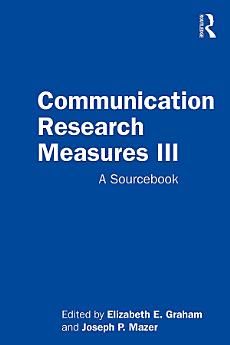Communication Research Measures III: A Sourcebook
આ ઇ-પુસ્તક વિશે
Volume III features entirely new content and offers an assessment of new measures in mass, interpersonal, instructional, group, organizational, family, health, and intercultural communication and highlights work in emergent subdisciplines in communication, including social media and new communication technologies, sports communication, and public relations. The “best of the best” from 2009 through today, the profiled research measures in Volume III serve as models for future scale development and constitute the main tools that researchers can use for self-administered measurement of people’s attitudes, conceptions of themselves, and perceptions of others.
This book is ideal for undergraduate and graduate courses that emphasize quantitative research methods, measurement, and/or survey design across communication studies disciplines.
લેખક વિશે
Elizabeth E. Graham (Ph.D., Kent State University, 1987) is Professor and Director of the School of Communication Studies at Kent State University. Beth’s research interests include three foci: (1) family communication patterns, particularly relationships in families experiencing transition and redefinition; (2) student learning and engagement; and (3) measurement and data analytic issues and trends in communication research. Her work has appeared in Communication Monographs, Communication Education, Communication Quarterly, Western Journal of Communication, Journal of Family Communication, Communication Reports, Communication Research Reports, and other communication-related journals. She has authored/co-authored several books and book chapters and co-edited Communication Research Measures I and II: A Sourcebook.
Joseph P. Mazer (Ph.D., Ohio University, 2010) is Professor and Chair of the Department of Communication at Clemson University. Joe’s research interests include communication in teaching and learning contexts, social media and new technologies, and measurement issues and trends in communication research. He has authored or co-authored over 80 research articles, book chapters, and books and has been ranked in the top 1% of prolific scholars in the communication discipline for the past 10 years. A recent study named him among the top five influential scholars in instructional communication. He recently completed terms as editor of the Basic Communication Course Annual and consulting editor for forums for Communication Education.




